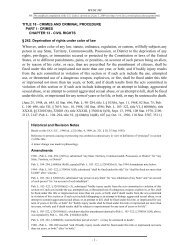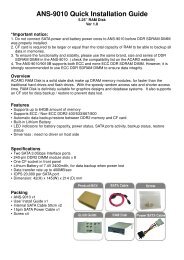2004 Instructions for Form 1040 (ALL) - Supreme Law Firm
2004 Instructions for Form 1040 (ALL) - Supreme Law Firm
2004 Instructions for Form 1040 (ALL) - Supreme Law Firm
Create successful ePaper yourself
Turn your PDF publications into a flip-book with our unique Google optimized e-Paper software.
<strong>Instructions</strong> <strong>for</strong><br />
Schedule B,<br />
after 1989.<br />
Interest and<br />
Ordinary<br />
Dividends<br />
Use Schedule B (<strong>Form</strong> <strong>1040</strong>) if any of the following apply.<br />
• You had over $1,500 of taxable interest.<br />
• Any of the Special Rules listed in the instructions <strong>for</strong> line 1 apply to you.<br />
• You are claiming the exclusion of interest from series EE or I U.S. savings bonds issued<br />
• You had over $1,500 of ordinary dividends.<br />
• You received ordinary dividends as a nominee.<br />
• You had a <strong>for</strong>eign account or you received a distribution from, or were a grantor of, or<br />
transferor to, a <strong>for</strong>eign trust. Part III of the schedule has questions about <strong>for</strong>eign accounts and<br />
trusts.<br />
You may list more than one so. See the instructions <strong>for</strong> lines 7a and 7b residence, list first any interest the buyer<br />
TIP payer on each entry space <strong>for</strong> on page B-2. paid you on a mortgage or other <strong>for</strong>m of<br />
lines 1 and 5, but be sure to<br />
seller financing. Be sure to show the<br />
clearly show the amount paid<br />
buyer’s name, address, and SSN. You must<br />
next to the payer’s name. Add the separate<br />
also let the buyer know your SSN. If you do<br />
amounts paid by the payers listed on an Part I. Interest<br />
not show the buyer’s name, address, and<br />
entry space and enter the total in the<br />
SSN, or let the buyer know your SSN, you<br />
“Amount” column. If you still need more<br />
may have to pay a $50 penalty.<br />
space, attach separate statements that are Line 1<br />
the same size as the printed schedule. Use<br />
Nominees<br />
the same <strong>for</strong>mat as lines 1 and 5, but show Interest<br />
If you received a <strong>Form</strong> 1099-INT that inyour<br />
totals on Schedule B. Be sure to put Report on line 1 all of your taxable interest. cludes interest you received as a nominee<br />
your name and social security number Interest should be shown on your <strong>Form</strong>s (that is, in your name, but the interest actu-<br />
(SSN) on the statements and attach them at 1099-INT, <strong>Form</strong>s 1099-OID, or substitute ally belongs to someone else), report the<br />
the end of your return. statements. Include interest from series EE total on line 1. Do this even if you later<br />
and I U.S. savings bonds. List each payer’s distributed some or all of this income to<br />
name and show the amount.<br />
others. Under your last entry on line 1, put a<br />
subtotal of all interest listed on line 1. Be-<br />
What’s New Special Rules low this subtotal, enter “Nominee Distribu-<br />
You may have to pay a penalty of up to<br />
tion” and show the total interest you<br />
$10,000 (more in some cases) if you are Seller-Financed Mortgages<br />
received as a nominee. Subtract this<br />
required to file <strong>Form</strong> TD F 90-22.1 (<strong>for</strong> If you sold your home or other property and amount from the subtotal and enter the re<strong>for</strong>eign<br />
accounts and trusts), but do not do the buyer used the property as a personal sult on line 2.<br />
Itemized Deductions Worksheet—Line 28<br />
Keep <strong>for</strong> Your Records<br />
1. Enter the total of the amounts from Schedule A, lines 4, 9, 14, 18, 19, 26, and 27 ............. 1.<br />
2. Enter the total of the amounts from Schedule A, lines 4, 13, and 19, plus any gambling and casualty<br />
or theft losses included on line 27. ................................................ 2.<br />
Be sure your total gambling and casualty or theft losses are clearly identified on the<br />
dotted lines next to line 27.<br />
3. Is the amount on line 2 less than the amount on line 1?<br />
No. STOP Your deduction is not limited. Enter the amount from line 1 above on Schedule A,<br />
line 28.<br />
Yes. Subtract line 2 from line 1 ............................................... 3.<br />
4. Multiply line 3 by 80% (.80) ....................................... 4.<br />
5. Enter the amount from <strong>Form</strong> <strong>1040</strong>, line 37 ............................ 5.<br />
6. Enter: $142,700 ($71,350 if married filing separately) .................... 6.<br />
7. Is the amount on line 6 less than the amount on line 5?<br />
No. STOP Your deduction is not limited. Enter the amount from line 1<br />
above on Schedule A, line 28.<br />
Yes. Subtract line 6 from line 5 ................................. 7.<br />
8. Multiply line 7 by 3% (.03) ........................................ 8.<br />
9. Enter the smaller of line 4 or line 8 ............................................... 9.<br />
10. Total itemized deductions. Subtract line 9 from line 1. Enter the result here and on Schedule A,<br />
line 28 ..................................................................... 10.<br />
B-1













